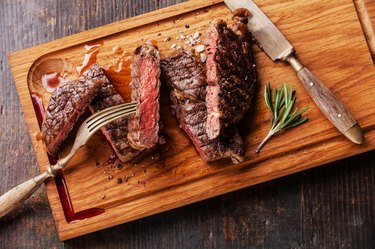
Meat is a good source of minerals, vitamins and protein in a healthy diet. However, if you find that you're feeling sick after eating meat, it's important to determine what's causing your nausea. Stomach pain after eating red meat or poultry can be a sign of improperly cooked food.
Meat Intolerance or Allergy?
Video of the Day
It's possible that your immune system is reacting to a protein in meat and creating antibodies that identify the meat as harmful. These antibodies release a number of chemicals, such as histamine, that cause allergic reactions, points out the Mayo Clinic. The symptoms may include nausea when eating meat.
Video of the Day
Meat allergies can develop at any age. Allergens can trigger a reaction to meat from any animal, including beef, lamb, pork, chicken or goat. Children with a milk allergy may be allergic to beef too, reports the American College of Allergy, Asthma and Immunology (ACAAI).
A meat allergy can cause unpredictable symptoms that range from mild to life-threatening. In addition to nausea, you may experience stomach cramps, indigestion, a stuffy or runny nose, swelling of the tongue and rash. ACAAI warns that a more severe reaction can include anaphylaxis.
Although rare, some people may become allergic to red meat after being bitten by a Lone Star tick. This parasite resides predominantly in the southeastern United States, according to the Mayo Clinic. It triggers a food allergy known as the alpha-gal syndrome, which may cause nausea and other symptoms three to six hours after eating red meat.
Food intolerances can cause some of the same symptoms as a food allergy but less severe. They are often limited to digestive problems, including nausea, states the Mayo Clinic. A meat intolerance may be caused by the absence of an enzyme needed to fully digest protein. Sometimes, it may result from sensitivities to food additives, such as the nitrates in processed meat.
Bacteria and Pathogens in Meat
If you have stomach pain after eating red meat, then foodborne pathogens, such as bacteria, viruses or parasites in the meat, may be to blame. Food poisoning is usually due to improper food handling and cooking. Meat that is contaminated may not look, taste or smell any different from foods that are safe to eat, warns the Academy of Nutrition and Dietetics.
Symptoms of food poisoning vary from one person to another and include gastrointestinal distress and stomach pain after eating red meat or poultry. These symptoms can develop as quickly as 30 minutes to several days after eating meat that has been infected, warns the Academy of Nutrition and Dietetics.
An August 2018 study published in BMC Research Notes reports that foodborne pathogens are the leading cause of illness and death in less developed countries. Researchers assessed the bacteriological quality of various raw meats. Fifty meat samples were tested, including chicken, pork, buffalo and goat meat.
The study results reported the presence of E. coli, salmonella, shigella and vibrio in higher amounts than the recommended standard microbial load, which could put consumers at risk of getting a foodborne disease.
Safe Meat Handling and Cooking
Meat is perishable and provides a prime medium for the growth of various microorganisms. Cooking it thoroughly and keeping it out of the danger zone — above temperatures of 140 degrees Fahrenheit or below 40 degrees Fahrenheit will help prevent the growth of bacteria, according to the Academy of Nutrition and Dietetics.
Leftovers need to be reheated to an internal temperature of at least 165 degrees Fahrenheit before serving. Foods left out at room temperature for more than two hours should be discarded. If it's 90 degrees or warmer in the room, meat should be thrown out after one hour.
Wash your hands often, especially after handling raw meat or poultry. To avoid cross-contamination, clean kitchen surfaces well, cautions the Academy of Nutrition and Dietetics. It is also advisable to wash table linens and reusable grocery totes regularly.
Baking, broiling, poaching or grilling over low heat is the proper way to cook meat at the recommended temperature. Using high heat, such as when frying or grilling directly over an open flame, may cause the formation of dangerous chemicals. According to the National Cancer Institute, when meat is cooked at a high temperature, heterocyclic amines (HCA) and polycyclic aromatic hydrocarbons (PAH) are formed, which have been found to cause changes in the DNA and may increase the risk of cancer.
Although high temperatures will kill bacteria, all types of meat cooked above 300 degrees Fahrenheit or those cooked for a long time tend to form more HCAs. Methods of cooking that expose meat to smoke contribute to PAH formation, warns the National Cancer Institute.
- Mayo Clinic: "Allergies - Overview"
- American College of Allergy, Asthma and Immunology: "Meat Allergy - Overview"
- Mayo Clinic: "Alpha-Gal Syndrome - Overview"
- Mayo Clinic: "Food Allergy vs. Food Intolerance: What's the Difference?"
- Academy of Nutrition and Dietetics: "Most Common Foodborne Pathogens"
- BMC Research Notes: "Food-Borne Bacterial Pathogens in Marketed Raw Meat of Dharan, Eastern Nepal"
- National Cancer Institute: "Chemicals in Meat Cooked at High Temperatures and Cancer Risk
Was this article helpful?
150 Characters Max
0/150
Thank you for sharing!
Thank you for your feedback!